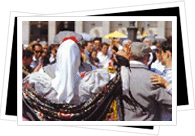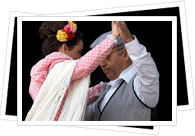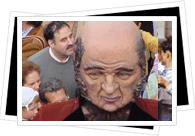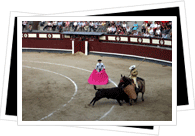Fiesta de San Isidro in Madrid
Madrid celebrates the Fiestas de San Isidro for 9 days, from the Friday before May 15 through the following Sunday. It's the most important, lively and emblematic Madrid festival of the year.
About San Isidro
 San Isidro was canonized on May 15, 1622 for miraculously making water rise to rescue his son from a well, along with a handful of other wondrous deeds. Hence he became Madrid's patron saint and, simultaneously, the "laborer/peasant saint" after his profession.
San Isidro was canonized on May 15, 1622 for miraculously making water rise to rescue his son from a well, along with a handful of other wondrous deeds. Hence he became Madrid's patron saint and, simultaneously, the "laborer/peasant saint" after his profession.
For more about San Isidro, you can visit the church of the same name on calle Toledo - built over the site where the miracle purportedly took place - about two blocks from the Plaza Mayor. The church holds a small museum with exhibits including the famous well along with a small collection of archaeological findings excavated in the region of Madrid.
San Isidro Traditions
Like most in Spain, this Madrid festival has largely lost its religious character. Instead, the city government uses San Isidro as a platform to represent the best of Madrid culture, old and new, from bullfights to break dancing. You'll enjoy a full calendar of concerts, plays, parades, fairs and special art exhibits, most free of charge.
Weekend partying is centered day and night around the Plaza de las Vistillas, Plaza de San Andrés and Puente de Segovia in the Austrias neighborhood, near the Plaza Mayor. At night, bars set up shop on the street, or "chiringuitos." Good luck elbowing your way through the hordes to get a "mini," the Spanish term for a huge plastic cup of mojito, beer, cocktail or mixed drink.
El Chotis, Chulapos, Castizos & Cocido
 The chotis is Madrid's typical music and dance, though strangely Scottish in origen. It became popular in the 19th century and was largely danced in the working class neighborhoods of Lavapiés and El Rastro. Those who lived in these areas did not have much money, but they dressed and danced brightly as if they did. Known as "majos" and "majas," or "chulapos" and "chulapas" (a variation of "chulo," which means cool or cocky), Goya immortalized these proud, attractive madrileños in numerous paintings which you can see at the Prado Museum.
The chotis is Madrid's typical music and dance, though strangely Scottish in origen. It became popular in the 19th century and was largely danced in the working class neighborhoods of Lavapiés and El Rastro. Those who lived in these areas did not have much money, but they dressed and danced brightly as if they did. Known as "majos" and "majas," or "chulapos" and "chulapas" (a variation of "chulo," which means cool or cocky), Goya immortalized these proud, attractive madrileños in numerous paintings which you can see at the Prado Museum.
"Castizo" is an adjective that describes anything typical of Madrid. Thus the "castizo" madrileños of today dress up like chulapos/as and dance the chotis or head down to the San Isidro Hermitage on the banks of the Manzanares River to eat cocido, a local kind of stew (see Foods in Madrid).
 Gigantes & Cabezudos
Gigantes & Cabezudos
Gigants (people on stilts) with "cabezudos" (big, satirical papier mache heads) parade around the city center, usually on the first Saturday afternoon of San Isidro.
Barquillos
You can buy barquillos all year round in front of the Palacio Real, but they are especially prevalent during San Isidro. Barquillos are wafers topped with chocolate or whipped cream to your liking. The vendors, called "barquilleros" dress like "chulapos" with a traditional vest and cap and carry around a "wheel of fortune" where you can gamble for more wafers.
 Bullfights
Bullfights
The Plaza de Toros de las Ventas schedules all the best bullfights for the Fiestas de San Isidro, every day at 5pm. (See Madrid bullfights for information).
You can find official San Isidro programming at the Madrid City Hall website: www.munimadrid.es
